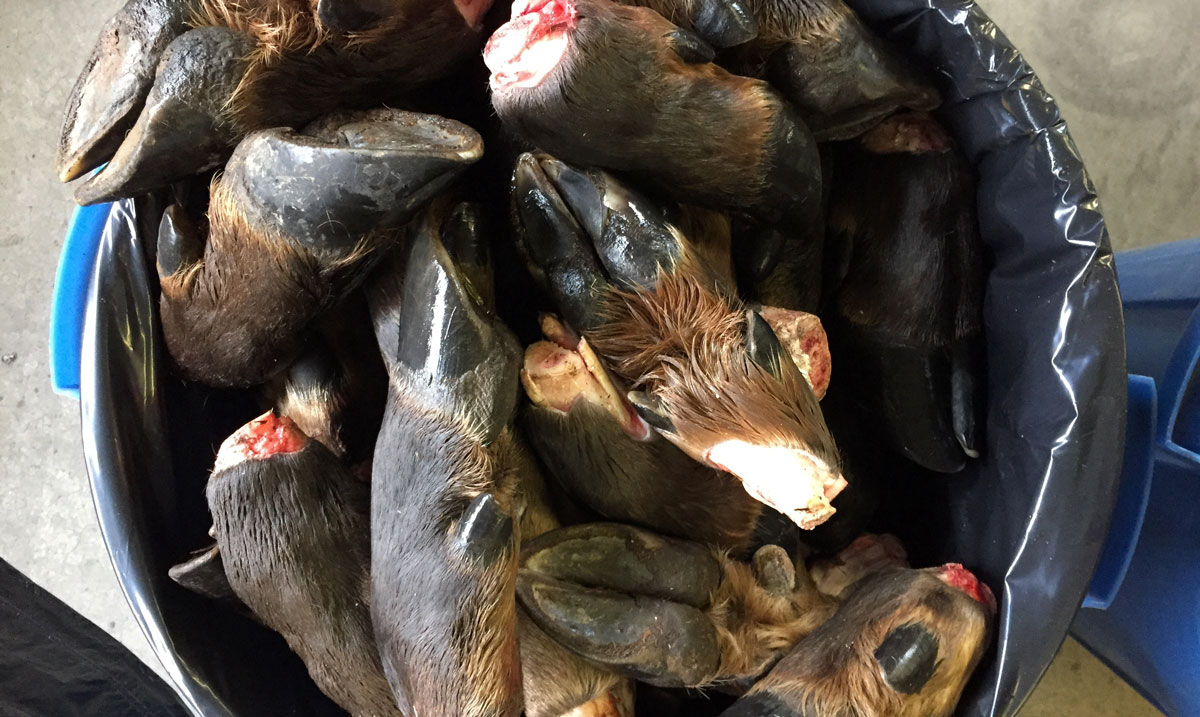Below is a post by the Washington Department of Fish and Wildlife.
The life of a WDFW scientist isn’t always glamorous. Some days you spend hours washing elk hooves with a garden hose. That’s what WDFW veterinarian Dr. Kristin Mansfield did for one day this fall — cleaning hundreds of hooves so she and researchers from Washington State University (WSU) and the United States Department of Agriculture (USDA) can learn more about treponeme-associated hoof disease, better known as TAHD or elk hoof disease.
The disease afflicts elk in Washington, Oregon and Idaho, and scientists consider a group of bacteria known as treponemes to have a causal role in the disease, similar to a hoof disease of domestic livestock known as digital dermatitis.
“But there are a lot of unknowns,” said WDFW veterinarian Mansfield. “There are other bacteria and factors playing a role in the development and transmission of this disease that we don’t understand.”
Documenting TAHD’s distribution and prevalence is a fundamental component of managing and researching the disease.
“We’ve used large scale citizen science efforts, aerial surveys, and hunter reporting to estimate prevalence, and they all give us consistent results,” said Kyle Garrison, WDFW statewide elk specialist. “Hunter reporting, however, is much cheaper and efficient than helicopter flights or managing dozens of volunteers across massive landscapes.”
Infection starts with a small lesion on the foot that grows into the hoof over time. As it worsens, the hoof capsule becomes undermined and can grow unusually long or at odd angles and the underlying tissues form cavities. In later stages the hoof capsules can slough off. The disease is restricted to hooves only, and usually the hoof on just one leg; almost always a hind leg.
In its later stages, TAHD is very recognizable by the deformed, overgrown, broken or sloughed hooves and the limping it causes. But before the disease advances to that stage, it can be difficult to spot.
“To feel comfortable using hunter reporting as an index of prevalence, we need to have a decent idea as to how well hunters can identify the disease,” said Garrison.
For the past several years, WDFW has asked hunters in southwest Washington, where elk hoof disease is most prevalent, to submit the hooves from elk they harvest. Hunters with elk tags in that area are sent a letter requesting the hooves, bags to put them in, and a questionnaire about the hooves of the elk they harvest. Once a year, a team of scientists spends days processing hundreds of hooves to collect data on TAHD, including how well hunters are able to identify the disease.
Fifteen hundred hoof collection kits were provided to hunters between 2016 and 2018, resulting in hundreds of hooves being turned in per year. From those submitted between 2016 and 2018, WDFW collected 180 complete hoof samples to both study and help determine how well Washington’s hunters recognize the signs of TAHD.
Of those 180 samples:
- 91 were not infected with TAHD, while 89 were infected.
- Hunters correctly assessed infected hooves as displaying signs of TAHD in 60% of all samples, and incorrectly for 40% of all samples.
- Hunters correctly assessed early-stage infections in 11% of samples, for a corresponding early-stage false negative rate of 89%.
- Not surprising, hunters correctly assessed late-stage infections in 92% of samples, for a corresponding late-stage false negative rate of 8%.
- Hunters incorrectly assessed hooves as displaying signs of TAHD in only 4% of samples (i.e., false-positive rate).
- False negative and false positive rates by year and by year-stage are generally consistent.
- It may seem that because hunters have a hard time identifying early stages of the disease WDFW can’t rely on hunter evaluations, but Garrison says that’s not true.
“It’s not really about being right or wrong, even biologists and veterinarians struggle to identify early stages of the disease. What is important is that we can quantify error rates,” he said. “Given the relatively large sample size and consistency in results, we’re comfortable using them to inform prevalence estimates, providing outreach to stakeholders, and informing future efforts involving hunters and TAHD.”
Another advantage of collecting and analyzing hooves, Garrison says, is that it provides a great opportunity for biologists at WSU and USDA to collect samples to use in other research on the disease. We expect this work to lead to a better understanding of TAHD and its transmission.
You can find more information on treponeme-associated hoof disease, and report limping elk or animals with deformities here.
(Photo source: Washington Department of Fish and Wildlife)
